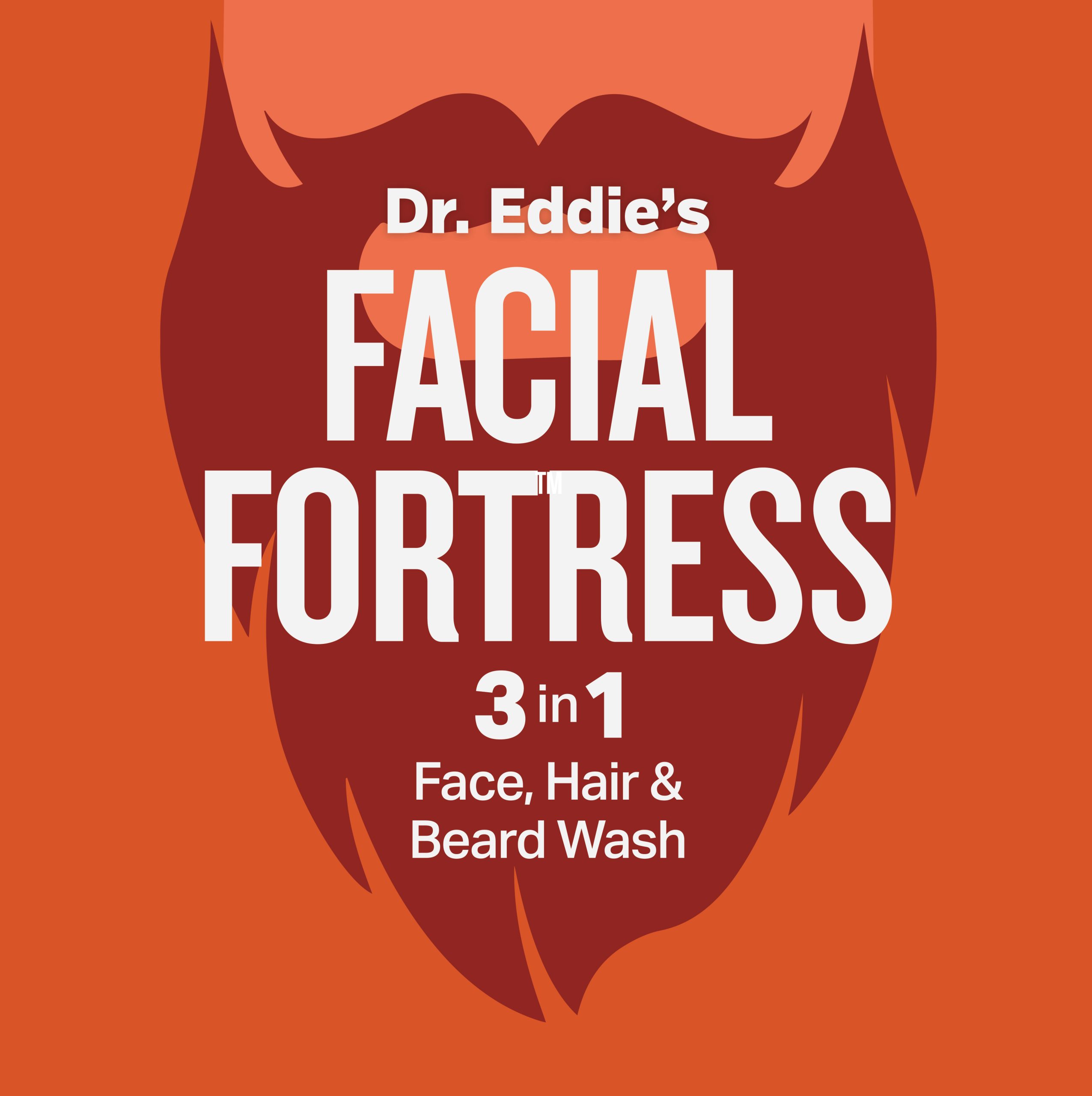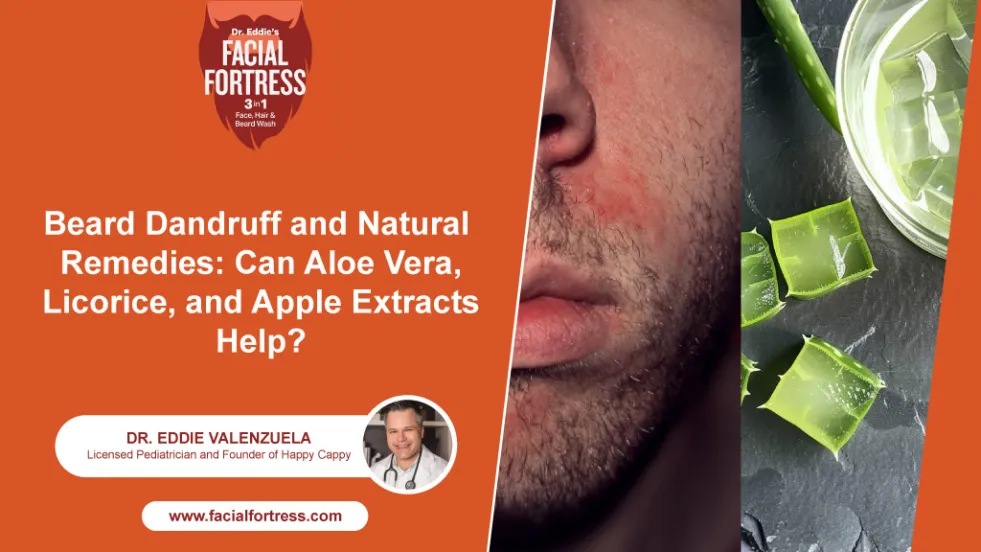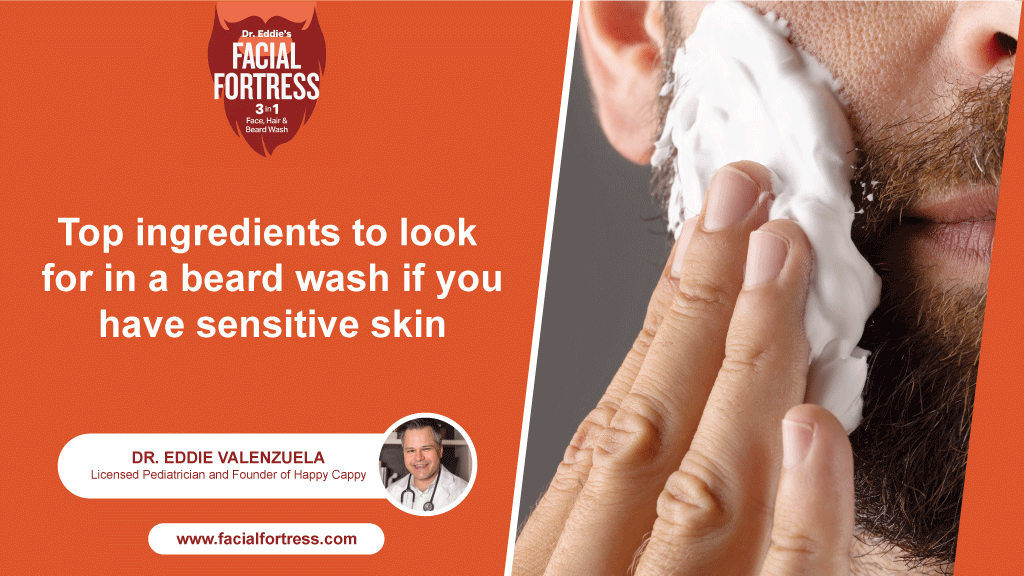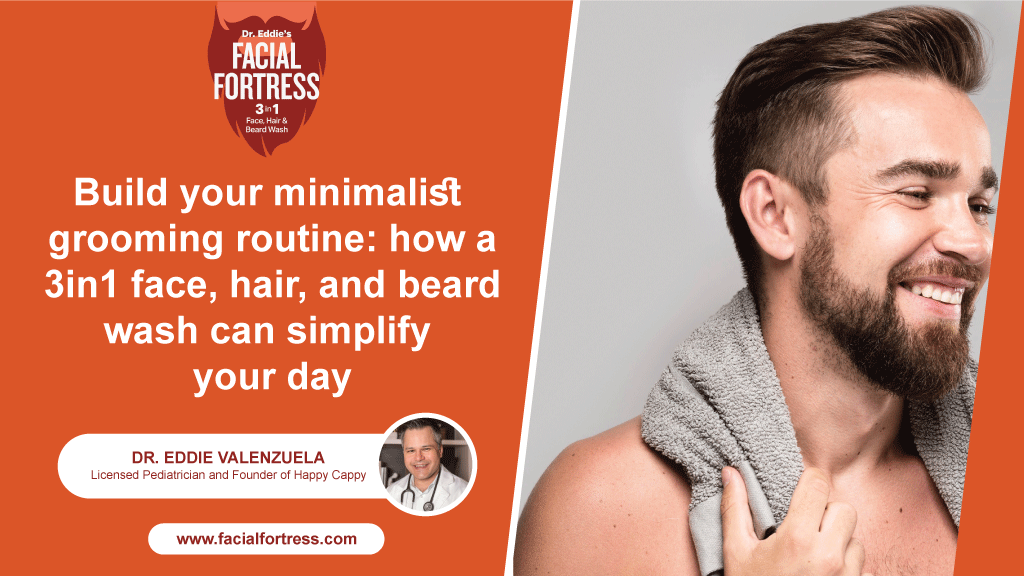How to Fix Patchy Beard? Causes, Solutions, and Beard Tips
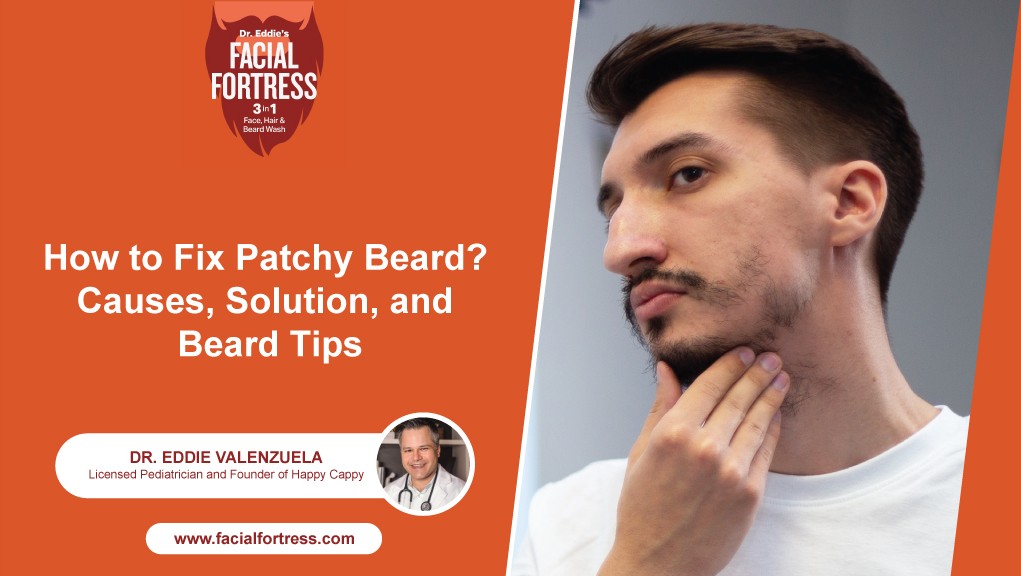
Growing a beard is not always a smooth journey. Some may experience itchiness, dryness, beard dandruff, and at times, those patchy spots that leave one wondering what went wrong. If your beard is not filling in evenly, then don’t worry, you are not alone.
Patchy beards are more common than you think; even Hollywood stars like Keanu Reeves and Dev Patel have them, and they confidently embrace them.
While genetics plays an important role in your beard growth, there are different ways to fill up the patchy areas. In this blog, we will help you understand how to fix a patchy beard and transform it into one that you can wear with confidence.
What is a Patchy Beard?
A patchy beard basically means uneven facial hair growth. When some areas of the beard have less or no hair growth as compared to the rest. This often results in a beard that is sparse and inconsistent in thickness.
A splotchy beard is very common in men, especially if you are growing it for the very first time. Before we jump into how to fix beard patchiness, it is important to understand the underlying cause behind it first.
What Causes a Patchy Beard?
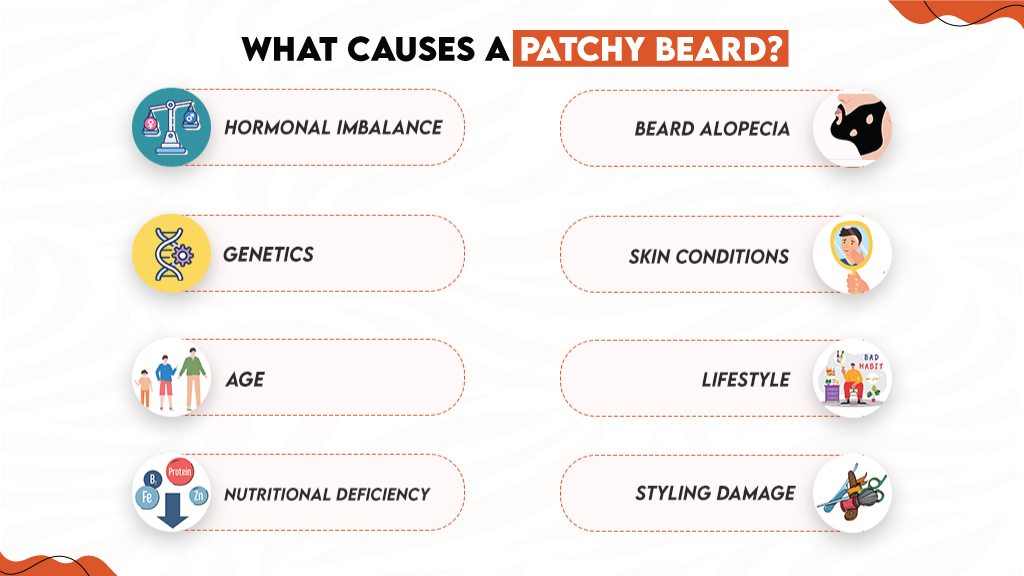
Ever wondered why you have a patchy goatee while your best friend is blessed with a full, thick beard? Patchy beard growth is caused by various factors, while some are in your control, others aren’t.
Here are some of the most common reasons for a patchy beard:
Hormonal imbalance is a major reason behind patchy, uneven beard growth. Hormones like testosterone and dihydrotestosterone play an important role in facial hair growth. They not only influence the speed of hair growth but also its thickness.
1. Hormones
One medical condition known as hypogonadism, which is either inherited or caused by factors such as injury and infection, can cause a decrease in the level of testosterone in the body.
A low level of testosterone can cause the facial hair follicles to remain unstimulated, making natural hair growth difficult and resulting in beard patching.
2. Genetics
Genetics is one of those factors that you have no control over. Genetics plays an important role in determining the thickness and growth pattern of hair. This is why some people may just naturally have thick, full beards due to genetics, while others may not.
Your DNA can affect various aspects of beard growth, such as hair follicle distribution and growth rate variation. If your genes say you will have fewer hair follicles in certain areas of your beard, then you would probably experience a patchy beard.
3. Age
A beard usually starts to grow around the age of 16 during puberty. While some may experience healthy hair growth even at this stage, others may only notice a light fuzz around their jawline and upper lips.
However, at this age, it is very unlikely that a full beard will grow because the hair follicles are not yet mature. For most men, beard growth improves after the age of 25 or 30 when the hair follicles fully mature.
So if your beard looks patchy before the age of 25, then don’t worry, it may fill in with time.
4. Nutritional Deficiency
This is a factor that you can control. An imbalance or unhealthy diet can lead to a patchy beard. Some important nutrients, such as biotin, vitamin D, protein, and zinc, play a crucial role in your beard growth and its thickness.
If your body is lacking any of these nutrients, it will focus on providing those available nutrients to other important organs rather than hair growth. As a result, you may experience thinner, weaker, and uneven beard growth.
5. Beard Alopecia
Alopecia areata is a condition that can cause bald patches on your scalp. This condition can also affect your beard, then it is usually known as alopecia barbae. In this condition, the white blood cells in the body start attacking the hair follicles.
And as a result, you experience sudden hair loss in the form of round patches. These patches can appear anywhere on the body, including your beard. So if you suspect that you are experiencing alopecia, immediately consult a doctor for the right treatment plan.
6. Skin Conditions
There are various skin conditions, such as malassezia folliculitis, psoriasis, eczema, beard dandruff, and seborrheic dermatitis, that can also lead to temporary hair loss in the beard and make it look patchy.
While conditions like eczema, dandruff, and seborrheic dermatitis may not directly cause hair loss, however, the inflammation and itching associated with them can often lead to hair shedding in certain areas of the beard.
7. Lifestyle
Your lifestyle plays an important role in both your overall and beard health. Factors such as stress, lack of sleep and exercise, poor diet, and smoking can slow down beard hair growth and cause patchiness.
This is one of those factors that are in your control; making healthy lifestyle choices can actually help you fix a patchy beard.
8. Styling Damage
Caring for your beard and styling it are healthy habits. However, most of us often make some small mistakes that can affect the beard’s health. Some of these common mistakes are:
- Overbrushing your beard.
- Using beard products with harsh chemicals.
- Blow drying on high heat.
- Vigorously rubbing your beard while drying it.
These mistakes can make your beard dry, brittle, and more prone to breakage, resulting in a patchy beard.
Can you Fix a Patchy Beard?
Now the question arises, can you actually fix a patchy beard? The answer to this is yes, however, it pretty much depends on the cause behind the patchiness.
Patience is key. Beards often appear patchy in the early stages of growth. However, with time, they may naturally fill in. So, before doing anything, wait and give your beard enough time to grow to its full potential.
While genetics and hormones can influence your beard growth, most beards have the potential to become less patchy and fuller with proper care and attention. But how exactly can you make it look less patchy? Keep reading to find out.
How to Fix a Patchy Beard?
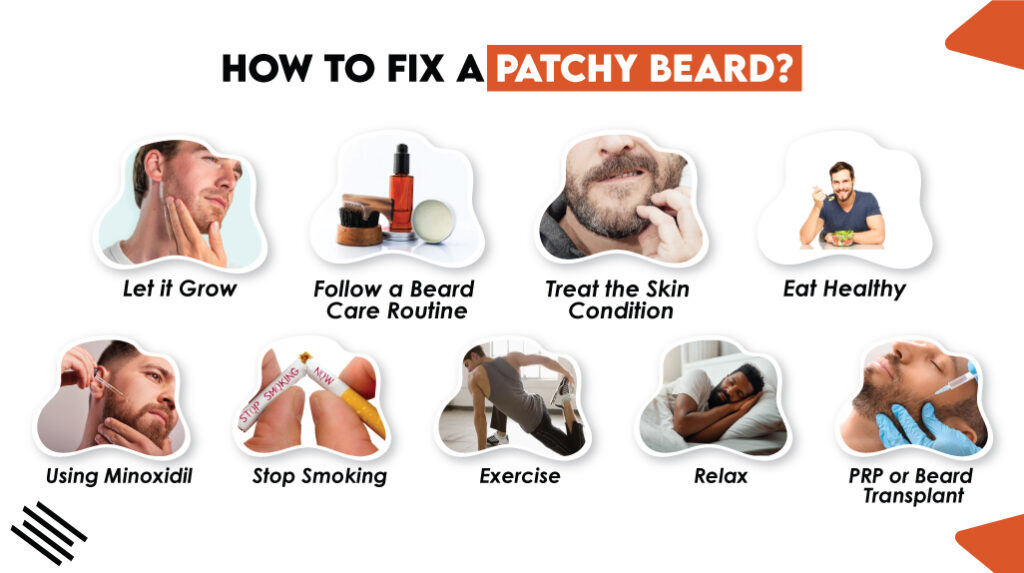
Here are some of the tried and tested tips to transform a patchy to full beard.
Let it Grow
As we were discussing before, growing a full and healthy beard takes time and patience. In the early stages of growth, it is pretty common to experience awkward, sparse spots and uneven growth in some areas.
Usually, it takes around 2 to 3 months to grow a solid base and around 6 to 8 months to grow a good length fuller beard. Most people give up too soon or start looking for shortcuts to make their beard look fuller, but patience is actually the real solution.
So if you are also in the early stages of your beard growth, then don’t worry, just give it some time, and things will start getting better. Wait at least 3 months, and after that, if you are still experiencing a very patchy beard, then you can start looking into other options.
Follow a Beard Care Routine
A proper beard care routine can have a great impact on your beard’s health, it can help improve the hair growth and the appearance of your patchy beard. A few common things that you must incorporate into your beard care routine are:
- Cleansing: Cleanse your beard with the help of a beard shampoo at least 2 to 3 times a week. Washing the beard properly helps you get rid of the dirt, dead skin cells, and sebum buildup in the beard that can clog the hair follicles of the beard and affect its growth.
- Moisturizing: just like our skin, the beard also requires moisturizing. Without proper hydration, your beard can become dry, rough, and irritate the skin beneath it.
This irritation can cause you to scratch your beard, which can weaken the hair follicles and cause hair loss. So, moisturize your beard with the help of beard oil or a balm after washing it.
- Brushing: Brushing your beard at least once daily has various benefits for your beard. It not only helps distribute the natural oils evenly across the hair strands but also promotes blood circulation in the skin, which supports healthy hair growth.
Additionally, brushing also trains your beard to grow in a consistent direction, giving it a fuller look.
You can also brush your beard and style it strategically by covering up the patchy areas.
Apart from adding these steps into your beard routine, you should also take care that you avoid the most common mistake of using harsh products on your beard. Instead, use a beard wash that is fragrance-free, paraben-free, and sulfate-free.
Because these chemicals can leave your beard dry, brittle, and weak, and sometimes result in hair loss.
Treat the Skin Condition
If your patchy beard is a result of a certain skin condition, then treating the root cause can help you get rid of the patchiness. For instance, if you are experiencing beard dandruff or seborrheic dermatitis, then you can use an anti dandruff beard shampoo to get rid of the flaking, itching, and irritation.
If you are experiencing eczema, then you must follow a proper eczema skincare routine that includes the use of an eczema shampoo or cleanser to wash the skin and an eczema cream to keep it moisturized.
If you are unsure which skin condition you are experiencing or how to treat it, it is best to consult a doctor and get the right treatment on time.
Eat Healthy
The food we eat can have an impact on our hair, skin, and overall health. It can also affect the growth of your beard. As we discussed before, certain nutrient deficiencies can lead to a patchy beard.
So, taking a healthy, balanced diet becomes essential to achieve a fuller beard. As beard hair is mainly made of keratin, consuming foods rich in protein, such as eggs, fish, nuts, and seeds, can support healthier hair growth.
A few other important nutrients that you must consume are:
Vitamin D: Vitamin D, found in foods like oily fish, red meat, eggs, and cereals, can help stimulate the hair follicles.
Iron: Iron and vitamin C obtained from citrus fruits and dried fruits work together to prevent hair loss.
B Vitamins: B vitamins, such as biotin, are present in fresh fruits and beans that can promote hair growth.
Zinc: Zinc, usually found in meat, dairy products, and oysters, can also promote healthy beard growth.
Apart from maintaining a healthy diet, it is also important to keep your body hydrated on the inside by drinking plenty of water daily can also help because dehydration weakens the hair follicles and results in hair loss.
Using Minoxidil
This is something that you must only do after the consent of a doctor or dermatologist, and should be used as advised by them. Minoxidil is a topical solution used for hair retention. It is available in both topical and oral forms.
It basically works by increasing the blood flow to the hair follicles and increasing the growth phase of hair, which, as a result, helps reduce hair loss and promotes regrowth. It is usually applied to the patchy areas to promote growth and give the beard a fuller and more even look.
Stop Smoking
Most of us don’t actually consider this, but smoking can affect the growth of your beard and hair on the scalp. Nicotine can restrict the blood flow to your hair follicles, cutting off the essential oxygen and nutrients that hair requires to grow properly, and increasing inflammation in the body; all of these effects can weaken your hair and slow down beard growth.
So if you are serious about fixing your beard patches, then cutting down on cigarettes or quitting them altogether can make a great difference.
Exercise
Regular exercise can help fix beard patches. Wondering how? Exercise helps improve beard growth by naturally boosting the testosterone level, increasing blood flow, and reducing stress hormones, also known as cortisol, in the body.
Here is how these 3 factors help fix the patches.
Testosterone level: It stimulates the hair follicles and promotes hair growth.
Blood Circulation: Helps deliver oxygen and nutrients to the hair follicles, which are essential for hair growth.
Reduced Cortisol: Reduced stress helps prevent hair thinning and patchiness.
So by staying active and adding any form of exercise, such as walking, yoga, running, or biking, will not only improve your physical health but also your beard health.
Relax
You must have heard about getting a good night’s beauty sleep. Yes, sleeping and getting enough rest are not only beneficial for your skin but also for your beard. Studies have shown that a lack of sleep can reduce testosterone levels in the body, which can result in a patchy beard.
Additionally, stress can negatively impact your beard growth, causing hair thinning or even hair loss in some cases. This is why it is essential to get plenty of sleep and manage stress. Staying calm and relaxed can help you get a healthy beard.
PRP or Beard Transplant
This is, you can say, the last resort, if nothing else is working, and you are desperate to fix a patchy beard, then you can go for clinical procedures like Platelet-Rich Plasma (PRP) and beard transplant.
In PRP therapy, platelet-rich plasma is extracted from your blood and injected into the bald spots to stimulate hair growth. This is a great option for people experiencing alopecia barbae. On the other hand, in a beard transplant, individual hair follicles are implanted at natural growth angles in the patchy areas to create a fuller look. These hair follicles are usually extracted from the neckline, back of the head, or other body areas.
How to Fill in a Patchy Beard?
Now that we have discussed some of the best and effective ways to fix a patchy beard. Did you know some simple tricks can actually make your beard look fuller without doing much?
If you are wondering “How to Make a Beard Less Patchy”. Here are a few things that you can do.
Brush it out
Brushing your beard every morning and covering the patchy areas with the rest of the hair can help you achieve a fuller look.
Apply Beard Balm
A beard balm not only helps nourish your beard, but it also helps in styling longer hair over the patchy areas. Beard balm can help keep everything in place for a longer period.
Use Topical Fibers
If you need a quick fix for an important occasion, then you can use topical fibers. Lightly sprinkle or spray the fibers in the patchy areas and pat the area with your fingers or brush your beard to give it a more natural look.
You can also use a fixing spray to keep the fibers in place for the rest of the day. One important thing about these fibers is that they are not permanent; they will rinse out when you wash your beard.
These quick fixes can be very beneficial for those who don’t want to go through PRP or beard transplant, and nothing else is working for them.
Taking Care of a Patchy Beard With Facial Fortress

Having a patchy beard doesn’t mean you can’t rock a stylish beard look. With Facial Fortress 3-in-1 Face, Hair, and Beard Wash, you can keep your beard clean, nourished, and flake-free, making even a patchy beard look its best.
The key to a great beard is following a proper beard care routine and regular cleansing. Our medicated beard shampoo contains pyrithione zinc as an active ingredient that can help you reduce the flaking, redness, and irritation associated with beard dandruff. It contains provitamin B5 to nourish your hair and skin, and natural skin and hair moisturizers such as apple, licorice root (no scent), and glycerin.
Plus, it is fragrance-free, paraben-free, and sulfate-free, making it a great option for those with sensitive skin.
Here are a few beard styles that can help you embrace your patchy beard.
Chin Strap Beard: This is great if you patchy beard on the cheeks. This style maintains a thin strip of hair along the jawline, extending to the sideburns.
Goatee: If you have thicker hair growth around the chin and mustache, then this style is for you. It creates a clean beard look around the chin and mustache while keeping the cheeks clean-shaven.
Modern Mutton Chop: If you have thick sideburns but a patchy beard on the cheeks and chin, then try this style.
Van Dyke Beard: If you have patchy beard around the cheeks then you can rock this look. Keep the beard around the chin and maintain your mustache; it is pretty much like a goatee, but the mustache and beard are disconnected from each other.
5’O’clock Shadow: This is a faint beard that gives a rugged, effortless look while subtly covering the patchy areas.
Brett Beard: This style focuses on the chin and jawline while keeping the cheeks bare. Which is a great option if you have a patchy beard on the cheeks.
Key Takeaways
- Patchy beards are very common in men, especially during the early stages of beard growth.
- Beard patchiness can be caused by various reasons, from genetics, hormonal imbalance, age, nutritional deficiencies, certain skin conditions, to your lifestyle choices.
- If you have a patchy beard due to genetics, it can be difficult to fix. However, you can easily fill in the patchy area by right brushing techniques, using beard balm, or using topical fibers.
- If other controllable factors cause the patchiness, then you can improve beard growth on those patchy areas by following a beard care routine, maintaining a healthy diet, exercising regularly, and getting enough sleep.
- If the patches are a result of a certain skin condition like beard dandruff, then treating it by using a dandruff shampoo for beard can help fix the patches.
- As for the last resort, if nothing works, then you can consult a doctor to explore options like minoxidil, PRP, and beard transplant.
- While you are working on fixing the patches you can embrace your patchy beard by choosing the right beard style like goatee, chin strap, van dyke, and brett beard. And keep your beard clean and healthy, and flake-free with the help of Facial Fortress Beard Shampoo for best results.
- Seborrheic Dermatitis vs. Regular Dandruff: What’s the Difference and How to Manage Them - November 17, 2025
- Beard Dandruff and Natural Remedies: Can Aloe Vera, Licorice, and Apple Extracts Help - November 17, 2025
- Top Ingredients to Look For in a Beard Wash If You Have Sensitive Skin - November 12, 2025
Recent Post
Frequently Asked Questions
Can a patchy beard be fixed?
Will a patchy beard grow out?
What is the 3-month beard rule?
Is a patchy beard due to lower testosterone?
How can I make my patchy beard look fuller?
Does shaving fix a patchy beard?
- Seborrheic Dermatitis vs. Regular Dandruff: What’s the Difference and How to Manage Them - November 17, 2025
- Beard Dandruff and Natural Remedies: Can Aloe Vera, Licorice, and Apple Extracts Help - November 17, 2025
- Top Ingredients to Look For in a Beard Wash If You Have Sensitive Skin - November 12, 2025
